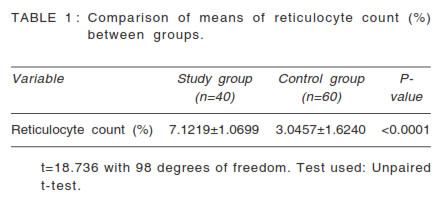and Pharmacology
Indian Journal of Physiology and Pharmacology |
 (252x320).jpg) |
Volume 58 - Number 2 April - 2014 (Current issue) ISSN 0019-5499 |
A Study of Reticulocyte Count in the Cord Blood of Pre-eclamptics and Healthy Pregnant Women Anita Rawat, Neena Srivastava, Anil Gangwar, |
Sir, Normal human pregnancy is associated with physiological blood changes, namely, neutrophilic leukocytosis, hyperlipidemia and procoagulant, hypofibrinolytic and inflammatory conditions. Preeclampsia (PE), a pregnancy-specific disorder characterized clinically by new onset hypertension and proteinuria after 20 wk of gestation, is the most frequently encountered medical complication during pregnancy, affecting ~3–5% of pregnant women worldwide In developing countries where access to health care is limited, PE is a leading cause of maternal mortality, with estimates of >60,000 maternal deaths per year (1). Worldwide PE is associated with a perinatal and neonatal mortality rate of 10% (2). In PE, extravillouscytotrophoblasts of fetal origin fail to invade the maternal uterine arteries resulting in a defective uteroplacental circulation and subsequent placental ischaemia (3). During pregnancy, in response to the increased turnover of Haemoglobin, due to the increased demand of oxygen consumption, there is an increased synthesis of erythropoietin - a specific erythropoiesis growth factor (4). When compared with normal pregnancy PE presents an exacerbation of inflammatory and oxidative stress markers. The release of mediators resulting from inflammatory cell activation can trigger changes in surrounding cells. These cell activation products may contribute to erythrocyte damage, accelerating their aging process and its premature removal. Pre eclamptics mothers show an increase in erythrocyte number, reticulocyte number and reticulocyte production index (RPI), reflecting an erythropoietic stimulus, which may be triggered by an accelerated removal of aged/damaged erythrocytes (5). This study was designed to see the association of cord blood reticulocyte count with PEc pregnancies. This case control study was conducted in Queen Marry Hospital of King George's Medical University, Lucknow, Uttar Pradesh from August 2011 to August 2012. All enrolled subjects gave their informed consent to participate in the study. Ethical clearance was taken from the institutional ethics committee. The study group comprised of 100 subjects between 18 to 35 yrs age group. Which 100 subjects, 60 controls (healthy pregnant women) and 40 cases (diagnosed PEc pregnant women as per ACOG guidelines) admitted in Queen Mary Hospital, KGMU were enrolled in the study. Inclusion criteria were healthy pregnant women and pre-eclamptic women as per ACOG guidelines. Exclusion criteria were pregnant women having history of hypertension, multifetal gestation, diabetes, chronic renal disease, miscarriage, antepartum haemorrhage, platelet disorders, maternal or fetal infection, epilepsy, autoimmune disorders, drug injection altering haematological profile. 2 ml of cord blood was collected in EDTA containing tube to perform the reticulocyte count within half an hour of collection by using Brilliant cresyl blue method. The calculation of reticulocyte percentage = Total no. of cells counted × 100 Reference Range : Adults and Children = 0.2-2%, Newborns(cord blood) = 2-6%. Data analysis was performed using Stata 11.2software (college station, Tx, US). Data are presented as mean±standard deviation. Statistical differences between the groups were calculated by using unpaired t-test P<0.05 was considered as statistically significant. Umbilical cord blood (UCB) reticulocyte count (%) data for controls and women with preeclampsia are shown in Table. |
 |
When comparing Umbilical cord blood Reticulocyte count (%), PEc group reported higher values .1219+1.0699) compared to control group (3.0457+1.6240) and the difference was highly significant (P<0.0001). The results of the present study of higher cord blood reticulocyte count in PE as compared to normal are comparable to previous studies (5, 6, 7). Rise in reticulocytes strongly suggests the development of a higher erythropoietic stimulus to face a higher RBC senescence and removal. One study reported a significantly higher erythropoietic stimulus in PEc pregnant women, and proposed that the stimulation of erythropoiesis could reflect an underlying placental hypoxic condition (8). In the present study, a significantly higher reticulcytes in UCB reflecting a higher RBC production in neonates from PEc pregnancies. The rise in RBC production may be triggered to face hypoxic condition and/or an accelerated RBC damage/aging/removal. The present study is one of ongoing steps in the direction of establishing role of reticulocyte count in pathophysiology of preeclampsia. However to achieve more confirmatory results further studies on larger sample size are needed. |
|